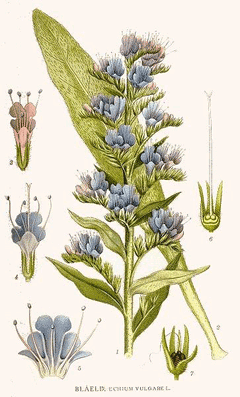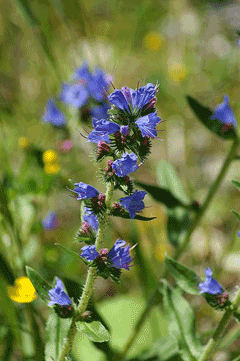 |
|
http://commons.wikimedia.org/wiki/File:87_Echium_vulgare.jpg |
 |
| http://commons.wikimedia.org/wiki/User:B%C3%B6hringer |
Translate this page:
Summary
Physical Characteristics

 Echium vulgare is a BIENNIAL/PERENNIAL growing to 0.9 m (3ft) by 0.6 m (2ft in).
Echium vulgare is a BIENNIAL/PERENNIAL growing to 0.9 m (3ft) by 0.6 m (2ft in).
It is not frost tender. It is in flower from July to October, and the seeds ripen from August to October. The species is hermaphrodite (has both male and female organs) and is pollinated by Bees, flies, Lepidoptera (Moths & Butterflies). The plant is self-fertile.
It is noted for attracting wildlife.
Suitable for: light (sandy), medium (loamy) and heavy (clay) soils, prefers well-drained soil and can grow in nutritionally poor soil. Suitable pH: mildly acid, neutral and basic (mildly alkaline) soils. It cannot grow in the shade. It prefers dry or moist soil. The plant can tolerate maritime exposure.
UK Hardiness Map
US Hardiness Map
Synonyms
Plant Habitats
Cultivated Beds; East Wall. In. South Wall. In. West Wall. In.
Edible Uses
Edible Parts: Leaves
Edible Uses:
Young leaves - raw or cooked[7, 9, 13]. They can be used as a spinach substitute[9]. Mild and mucilaginous[K]. Although somewhat hairy, when chopped up finely they are an acceptable part of a mixed salad[K]. Eating the leaves is said to stimulate sexual desire[9]. Use with caution, there is an unconfirmed report of toxicity[21].
References More on Edible Uses
Medicinal Uses
Plants For A Future can not take any responsibility for any adverse effects from the use of plants. Always seek advice from a professional before using a plant medicinally.
Antitussive Aphrodisiac Demulcent Diaphoretic Diuretic Emollient Pectoral Vulnerary
Viper's bugloss was once considered to be a preventative and remedy for viper bites[254]. It is related to borage, Borago officinalis, and has many similar actions, especially in its sweat-inducing and diuretic effects[254]. In recent times, however, it has fallen out of use, partly due to lack of interest in its medicinal potential and partly to its content of pyrrolizidine alkaloids which are toxic in isolation[254]. The leaves and flowering stems are antitussive, aphrodisiac, demulcent, diaphoretic, diuretic, pectoral and vulnerary[4, 7, 222]. An infusion of the plant is taken internally as a diuretic and in the treatment of fevers, headaches, chest conditions etc[244, 254]. The juice of the plant is an effective emollient for reddened and delicate skins, it is used as a poultice or plaster to treat boils and carbuncles[7, 254]. The leaves are harvested in the summer and can be dried for later use[7]. The roots contain the healing agent allantoin[222]. The plant is said to be efficacious in the treatment of snake bites[4]. When chopped up finely, the fresh flowering heads can be made into a poultice for treating whitlows and boils[7].
References More on Medicinal Uses
The Bookshop: Edible Plant Books
Our Latest books on Perennial Plants For Food Forests and Permaculture Gardens in paperback or digital formats.

Edible Tropical Plants
Food Forest Plants for Hotter Conditions: 250+ Plants For Tropical Food Forests & Permaculture Gardens.
More

Edible Temperate Plants
Plants for Your Food Forest: 500 Plants for Temperate Food Forests & Permaculture Gardens.
More

More Books
PFAF have eight books available in paperback and digital formats. Browse the shop for more information.
Shop Now
Other Uses
References More on Other Uses
Cultivation details
Succeeds in any good garden soil but flowers best when the soil is not too rich[1]. Requires a sunny position[200]. The plant is very deep rooted[4]. A good bee plant[4].
References Carbon Farming Information and Carbon Sequestration Information
Temperature Converter
Type a value in the Celsius field to convert the value to Fahrenheit:
Fahrenheit:
The PFAF Bookshop
Plants For A Future have a number of books available in paperback and digital form. Book titles include Edible Plants, Edible Perennials, Edible Trees,Edible Shrubs, Woodland Gardening, and Temperate Food Forest Plants. Our new book is Food Forest Plants For Hotter Conditions (Tropical and Sub-Tropical).
Shop Now
Plant Propagation
Seed - sow February-May or August-November in situ. Germination usually takes place within 2 - 3 weeks at 15°c. If the seed is in short supply then it can be sown in pots in a cold frame. When they are large enough to handle, prick the seedlings out into individual pots and plant them out in the summer.
Other Names
If available other names are mentioned here
Native Range
TEMPERATE ASIA: Cyprus, Turkey (northwest), Russian Federation-Ciscaucasia (Ciscaucasia), Armenia, Azerbaijan, Georgia, Russian Federation (Dagestan), Russian Federation-Western Siberia (Western Siberia (south)), Kazakhstan, Kyrgyzstan, Tajikistan, Turkmenistan, Uzbekistan, China (Xinjiang Uygur Zizhiqu (north)) EUROPE: Denmark, United Kingdom, Ireland, Sweden, Austria, Belgium, Switzerland, Czech Republic, Hungary, Netherlands, Poland, Slovakia, Russian Federation (European part), Belarus, Estonia, Lithuania, Latvia, Moldova, Ukraine (incl. Krym), Albania, Bulgaria, Greece, Italy (incl. Sardinia, Sicily), Romania, Spain, France (incl. Corsica), Portugal
Weed Potential
Right plant wrong place. We are currently updating this section.
Please note that a plant may be invasive in one area but may not in your area so it's worth checking.
Conservation Status
IUCN Red List of Threatened Plants Status :

Growth: S = slow M = medium F = fast. Soil: L = light (sandy) M = medium H = heavy (clay). pH: A = acid N = neutral B = basic (alkaline). Shade: F = full shade S = semi-shade N = no shade. Moisture: D = dry M = Moist We = wet Wa = water.
Now available:
Food Forest Plants for Mediterranean Conditions
350+ Perennial Plants For Mediterranean and Drier Food Forests and Permaculture Gardens.
[Paperback and eBook]
This is the third in Plants For A Future's series of plant guides for food forests tailored to
specific climate zones. Following volumes on temperate and tropical ecosystems, this book focuses
on species suited to Mediterranean conditions—regions with hot, dry summers and cool, wet winters,
often facing the added challenge of climate change.
Read More
Expert comment
Author
L.
Botanical References
17200
Links / References
For a list of references used on this page please go here
Readers comment